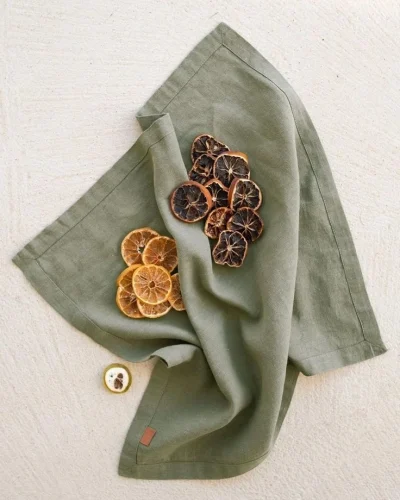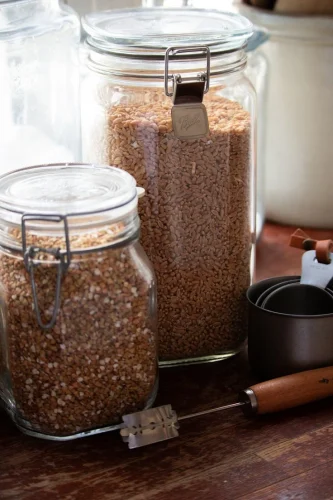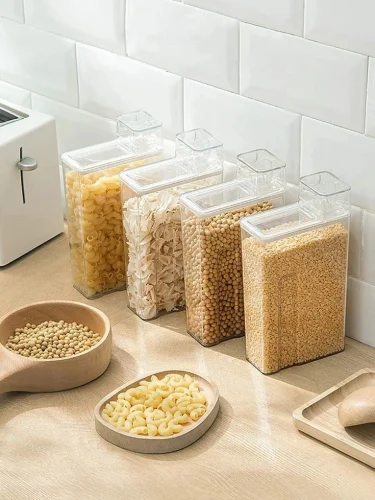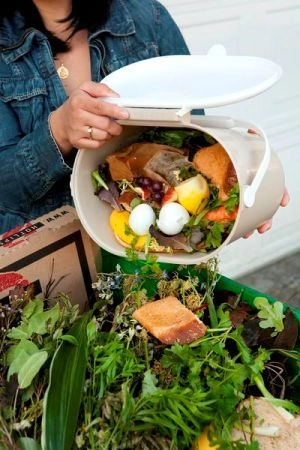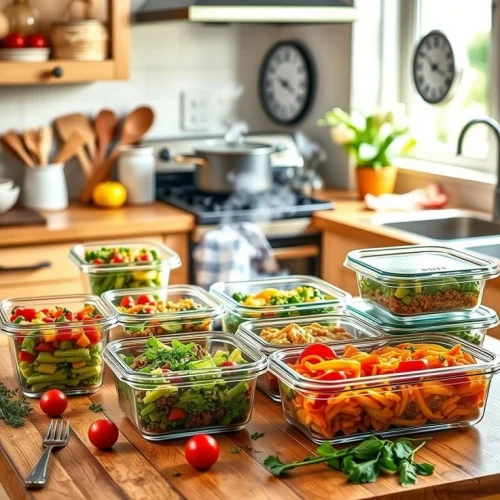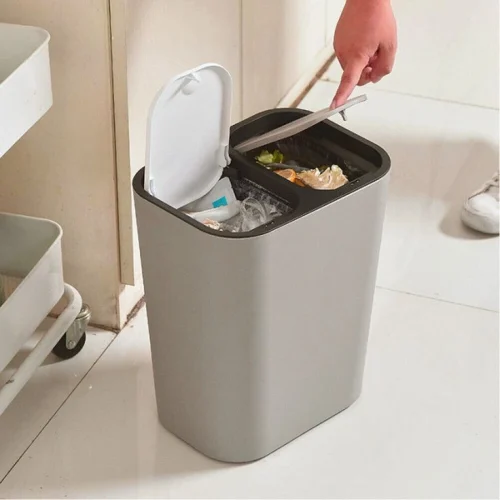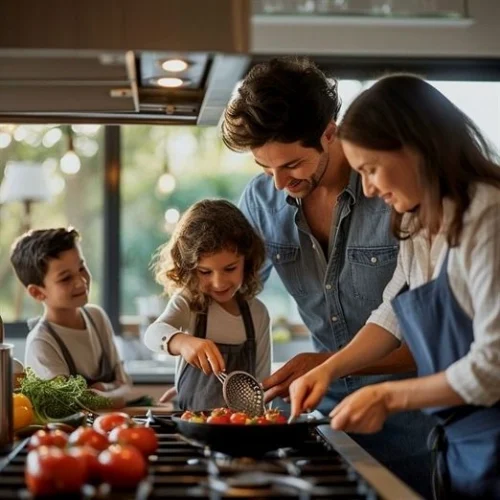
Child-Safe Windows: 11 features Every Parent Should Know
June 20, 2025
Free AI Interior Design Apps for Home Designing Without Hiring a Designer
June 21, 2025Most of us don’t realise how much waste our kitchen creates until we actually see it pile up. Plastic packaging, spoiled vegetables, takeaway containers, paper napkins, random jars we toss without a second thought…the list goes on.
If you're feeling a little shocked (or guilty), it's okay. That’s just how most of us have been doing things for years.
But not anymore. With a few small, mindful changes, you can turn your kitchen into a greener, more sustainable space.
In this blog, we have shared 10 tips to help you build a zero-waste kitchen that’s easily doable and good for the planet.
10 Tips To Create A Zero-Waste Kitchen
A zero-waste kitchen is not a trend. It’s a mindset shift. It’s not about being perfect. It’s about becoming more aware of how your space works or how much control you have over what comes in and goes out of your kitchen.
1. Swap single-use items with reusable ones.
Swapping single-use items with reusable ones is the first and easiest step. Look around your kitchen and identify what you use once and get rid of them.
For instance, instead of
- Paper towels, use washable cloth napkins or old t-shirts cut into squares
- Foil and plastic wrap, use beeswax wraps or silicone stretch lids
- Plastic grocery bags, use jute or cloth shopping bags
- Disposable cutlery, use stainless steel or bamboo travel sets, handy
- Plastic dish sponges, use natural loofas, coconut coir scrubbers or compostable brushes
The idea is not to throw out everything and buy new reusables. It is to replace the, gradually as they run out, with eco-friendly products that last for years.
2. Buy in bulk and carry your own containers.
Buying dry goods in bulk not only saves money but also reduces packaging waste. Many local stores now allow you to carry your own jars or cloth bags.
Things you can buy in bulk in your own containers and store:
- Grains, pulses, pasta and flours
- Dried fruits, nuts and seeds
- Spices, herbs and condiments
- Snacks like murmura, peanuts, or granola
Label your containers clearly, and store them in a cool, dry place. You will be surprised how organised and minimalist your pantry looks.
3. Label, store, and eat your leftovers on time.
Food waste is one of the biggest problems in a zero-waste kitchen. Sometimes we buy more than what we need. Sometimes, we forget it’s there already. To avoid the same,
- Buy transparent containers to see what’s inside at a glance
- Keep leafy greens in airtight containers with a paper towel to absorb moisture
- Label everything using a masking tape and a marker with the date
- Follow the FIFO (First in, first out) method and use older items before newer ones
- In your fridge, place a basket in a zone and name it as ‘use me first’, for near-expiry products
4. Start a kitchen composting system.
Even if you do everything right, there will be food scraps- banana peels, onion skins, tea leaves, and so on. The best thing to do is compost them.
Easy options include,
- A countertop compost bin for daily recollection
- Bokashi bins (best for small kitchens)
- Electric composters for apartments
- Local community composting centres or terrace composters
What can you compost? | What can you not compost? |
|
|
It might take a little learning, but composting is one of the most impactful things you can do for Earth.
5. Cook only what you need.
Let’s do a quick check. Open your fridge, and you will find at least one vegetable that you bought weeks back rotting.
- Make a meal plan every Sunday and shop only for what you need
- Check your pantry and fridge before shopping
- Prepare your meals in batches, whenever possible- cut, portion, and freeze
- If you have anything leftover from the previous night, finish it the first thing in the morning
This is one of the best waste-free cooking tips to save money, reduce clutter, and keep your fridge from becoming a dumpyard.
Also read: Eco-friendly materials for sustainable architecture.
6. Upgrade to eco-friendly kitchen products.
Remove those toxic or waste-heavy items from your kitchen immediately. Some eco-friendly kitchen products include
- Compostable garbage bags
- Refillable dish soap bottles
- Stainless steel scrubbers
- Reusable silicone freezer bags
- Wooden, stainless steel or bamboo utensils.
7. Reduce energy and water waste with smart design.
If you are renovating, building or just reorganizing, bring in a little sustainable kitchen design.
- Have separate bins or counters for dry waste and wet waste
- Install aerators to reduce water usage without affecting the flow
- Use energy-efficient, star-rated appliances to save electricity long-term
- Let natural light come in to keep your kitchen bright and warm
- Choose sustainable materials, like recycled wood, stone, or metal, over plastic finishes
8. Don’t try to be perfect, but rather try to stay consistent.
Let’s be honest. If you are just starting, you are going to make mistakes.
- You will forget your cloth bag
- You will throw away food now and then
- You will buy something wrapped in plastic because it’s urgent
So, don’t be too hard on yourself. A zero-waste kitchen is not about doing everything right from the beginning. It’s about staying consistent and doing better than yesterday.
9. Get creative with scraps and leftovers
Scraps and leftovers need not always go to the bin or compost.
- If you have stale bread, make breadcrumbs or croutons
- If you have vegetable peels, make a homemade broth
- If you have citrus peels, make a natural cleaning spray with vinegar
- If you have leftover rice, make a stir-fry or curd rice
- If you have overripened fruits, make smoothies, ice cream, or muffins
There’s always a way with a little creativity.
10. Involve your family or roommates
Zero-waste kitchen should be everyone’s motto. You can create one, only if everyone cooperates.
- Place a “do not waste” sign in the fridge or next to the dustbin
- Teach kids, partner or housemates to segregate waste
- Involve them in composting the food waste
Also read: 7 best flooring tile options for the kitchen.
Final Thoughts
At GreenFortune, we believe sustainability starts at home. We offer eco-friendly uPVC windows & doors that are easy to maintain, energy-efficient, long-lasting, and weather and termite resistant.
FAQs
1). Are zero-waste kitchen products expensive?
Not all zero-waste kitchen products are expensive. Some items may cost upfront, like beeswax wraps or steel containers, but they last longer, saving you costs later. Many products, like reusable jars or cloth napkins, cost very little.
2). How to avoid food waste when cooking for one or two people?
To avoid food waste when cooking for one or two people, cook in smaller portions, freeze extras, and plan meals using overlapping ingredients. You can label leftovers with dates and put them in see-through containers so nothing gets forgotten or thrown out.
3). How to dispose plastic food containers delivered by the restaurants?
Wash the plastic containers thoroughly, dry and clean them and drop them at local dry waste collection points or recycling centres near you. Avoid throwing the container with the food.








